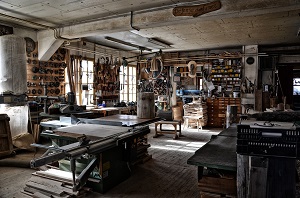![]() Supply Chain Disruptions is a news and information topic monitored and covered by: Prepper Watch – Homesteading
Supply Chain Disruptions is a news and information topic monitored and covered by: Prepper Watch – Homesteading
Introduction
Modern homesteading and prepping often rely more on external inputs than we like to admit. Whether it’s ordering heritage seeds online, driving into town for animal feed, or waiting on a delivery for replacement parts and tools, many of our operations are vulnerable to one weak link in the supply chain.
When global events—be they pandemics, wars, economic crashes, or natural disasters—interrupt these supply chains, those living off the land face serious challenges. The shelves empty, shipping stalls, and prices skyrocket. Preppers and homesteaders must plan for a future where self-reliance isn’t just a philosophy, but a necessity.
Seeds: The Foundation of Food Security
Relying on Seed Companies
Most small-scale growers depend on annual seed purchases. This reliance creates a fragile dependency: if the seed catalogs don’t arrive, planting may not happen.
Solutions:
- Seed Saving
- Learn to save seeds from heirloom, open-pollinated plants.
- Avoid hybrids, which may not breed true.
- Practice fermenting tomato seeds, drying beans, and winnowing lettuce seeds.
- Seed Libraries & Exchanges
- Start or join a local seed bank or seed swap network.
- Share hardy, regionally adapted seeds.
- Store Seeds Properly
- Keep seeds cool, dry, and dark.
- Use airtight containers or vacuum sealing with desiccants.
- Rotate your stock every couple of years.
- Diversify Your Seed Stock
- Maintain a broad variety of vegetable, grain, and medicinal plant seeds.
- Prioritize calorie crops (potatoes, corn, beans) and quick growers (radishes, greens).
Feed: Sustaining Your Animals Without the Feed Store
Modern Dependency
Commercial feed keeps chickens laying, pigs growing, and goats milking. If that bagged feed doesn’t show up, animals suffer—and so do you.
Alternatives:
- Grow Your Own Animal Feed
- Corn, sunflowers, pumpkins, amaranth, and millet can feed birds and livestock.
- Fodder systems (sprouted grains) can stretch your feed supply, especially in winter.
- Plant forage crops like alfalfa and clover.
- Kitchen and Garden Scraps
- Save peelings, damaged produce, and leftovers for chickens and pigs.
- Grow extra garden space with “seconds” for feed purposes.
- Pasture Management
- Rotational grazing extends pasture health.
- Allow chickens to free-range for bugs and greens.
- Insect Farming
- Raise black soldier fly larvae or mealworms as a protein source.
- Use waste to feed the bugs, then feed the bugs to animals.
- Fermented Feed
- Soaking grains improves digestibility and increases nutritional value.
- Helps stretch feed rations further.
Tools: The Hardware of Self-Sufficiency
Modern Tools and Equipment
Most homesteaders use a mix of manual and powered tools—tillers, chainsaws, solar batteries, irrigation timers, hand tools, fencing gear, plumbing supplies. But every one of these items could become scarce when supply chains falter.
Strategies:
- Stock Redundancies
- Keep two of each critical hand tool: shovels, pruning shears, hatchets, etc.
- Store extra parts: O-rings, spark plugs, chains, belts, washers.
- Learn Tool Maintenance and Repair
- Sharpen, oil, and store tools properly to extend life.
- Know how to replace handles, chains, or blades.
- Invest in Durable, Manual Tools
- Old-school, no-electric tools like scythes, hand-crank grain mills, and manual well pumps never go obsolete.
- Scavenge and Upcycle
- Collect scrap wood, nails, screws, and metal parts.
- Salvage from abandoned buildings, estate sales, or auctions.
- Build a Community Tool Library
- Share costly tools like log splitters or welders among trusted neighbors.
Bartering and Mutual Aid
When Money Can’t Buy What You Need
In a supply-constrained world, your local community becomes your new store. A thriving barter system can ensure that even if you’re missing something, someone nearby may have it—and vice versa.
Ideas for Barter:
- Seeds for labor.
- Feed for firewood.
- Tools for eggs or fresh produce.
Organizing Local Networks:
- Create a community inventory of resources and skills.
- Establish monthly trade days or informal exchanges.
- Use radio, signal boards, or local bulletin boards to share needs and offers.
Localizing Supply Chains
Shrinking the Distance Between You and Your Goods
Even before disaster strikes, begin shifting your supply lines closer to home. Buy from regional seed producers. Choose locally milled feed. Forge relationships with tool suppliers and fix-it folks nearby.
Local Resilience Tips:
- Support regional farmers, feed stores, blacksmiths, and nurseries.
- Join or form a co-op for shared bulk purchases.
- Visit garage sales, auctions, and antique stores for pre-electric tools and equipment.
DIY Substitutes for Commercial Products
Be Your Own Manufacturer
If you can’t buy it, make it. With basic tools, knowledge, and resourcefulness, many essential items can be home-built or improvised.
Homemade Solutions:
- Make soap from lard and wood ash.
- Build seed trays, cold frames, and hoop houses from scrap.
- Use wood ash for pest control or garden fertilizer.
- Ferment compost tea for plant nutrients.
Skill-Building Projects:
- Blacksmithing or simple metalworking.
- Leather and fabric repair.
- Rope making and woodworking.
Establishing a Local Supply Cache
Hedge Against Disruption
Just like food storage, stockpiling essentials in advance protects against shortages. Don’t hoard, but do prepare.
Smart Cache Items:
- Seed vault (heirloom/open-pollinated seeds).
- Basic hand tools (spare shovels, pruning tools, files, saw blades).
- Fasteners (nails, screws, fencing staples).
- Feed supplements (minerals, oyster shell, grit).
- Manual irrigation components (hoses, fittings, spigots).
Storage Tips:
- Use labeled, watertight bins in a cool, dry place.
- Regularly rotate and inspect for rust, mold, or pest damage.
- Maintain a written or digital inventory.
Knowledge Is the Ultimate Backup
If You Know How, You Can Adapt
Tools can rust, seeds can spoil, and feed can run out—but knowledge stays with you. A prepared mind is more valuable than a stocked shed.
Build Your Knowledge Base:
- Learn to identify wild edibles and medicinal plants.
- Understand composting, soil science, animal behavior, and herbal remedies.
- Subscribe to homesteading books, manuals, and offline resources.
- Take notes, print critical documents, and build a physical binder of know-how.
Critical Skills to Develop:
- Welding, carpentry, sewing, water filtration, fermentation.
- Butchering, baking without electricity, animal midwifery.
- Seed-saving, food preservation, tool repair.
In Summary
The longer you homestead, the more you realize true independence doesn’t come from a single piece of land or a large stockpile—it comes from resilience. That means thinking ahead, building redundancies, and forming local webs of support.
In a world where global shipping delays, economic instability, and geopolitical tensions are growing threats, those who prepare to live with less reliance on external supply chains will be the ones who endure—and thrive.
Whether you’re just starting your prepping journey or deep into your homesteading lifestyle, now is the time to tighten your loops, build your skills, and prepare for a more localized, self-sufficient future. The tools, seeds, and feed you need may not always be for sale. But with foresight and planning, they’ll already be in your hands—or growing in your soil.

